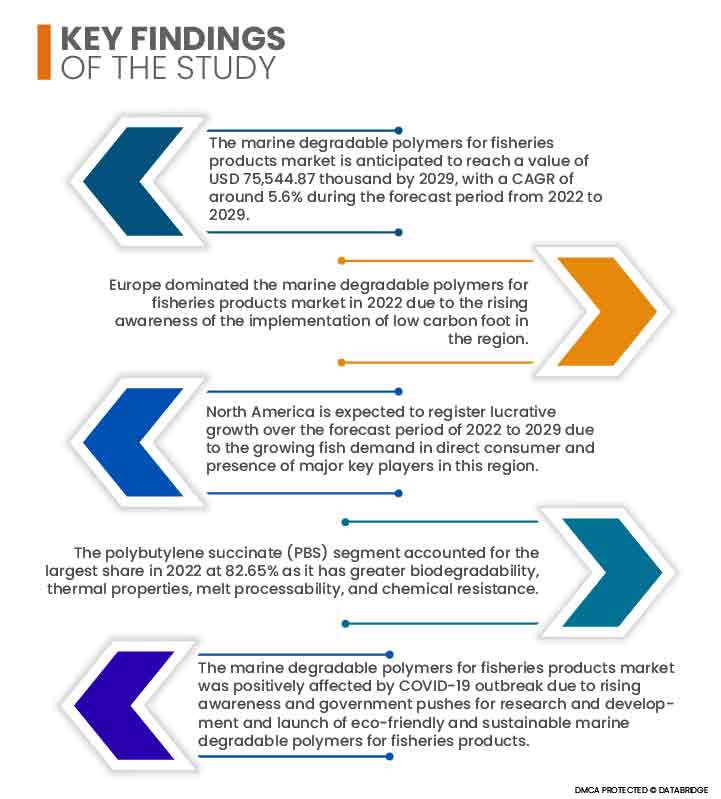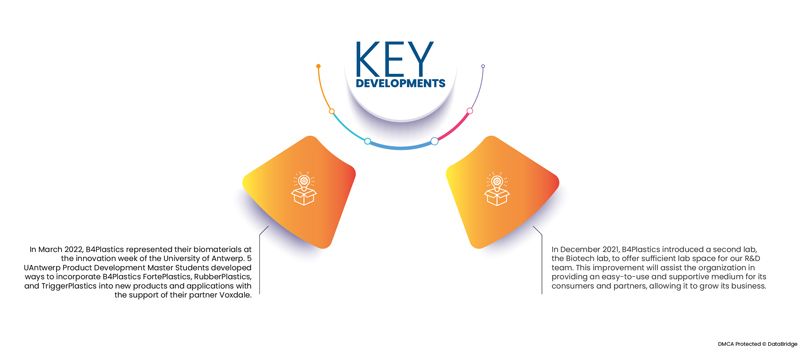Hooks, lines, sinkers, floats, fishing nets, rods, reels, spears and gaffs, and other equipment and tools are covered by the global marine degradable polymers for fisheries goods market. Degradable polymers are widely employed in practically every industry for various purposes. Polymers that degrade or breakdown naturally through the bacterial decomposition process are known as degradable polymers. These materials are environmentally friendly and help to reduce carbon emissions. The goal of using these materials is to eliminate plastic pollution in the sea and waterways, which is a major hindrance to the total fish production market. These materials have desirable features such chemical stability, moisture resistance, and thermoplastic properties. For fishery products, a variety of marine degradable polymers are available.
Access Full Report @ https://www.databridgemarketresearch.com/reports/global-marine-degradable-polymers-for-fisheries-products-market
Data Bridge Market Research analyses that the marine degradable polymers for fisheries products market is expected to grow at a CAGR of 5.6% in the forecast period of 2022 to 2029 and is expected to reach USD 75,544.87 thousand by 2029. The expansion of the global marine degradable polymers for fisheries products market will be fueled by increasing fish demand in direct consumer and shifting towards of growing phase out of single-use plastic. Furthermore, factors such as rising awareness about ghost fishing and growing importance of bio-based polymers as a replacement for conventional counterparts will boost the market’s growth rate.

Rising popularity owing to surging awareness towards implementation of low carbon foot is expected to drive the market's growth rate during the forecast period.
Materials with a low carbon footprint are those with a low carbon content. The smaller the carbon concentration, the lower the carbon footprint rate. Plastic nets and fish collecting equipment that remain in the water and affect the water ecosystem are the main source of increased carbon footprint rates in the ocean or water fields. The market is being driven by a growing awareness of the need for low carbon footprint materials. Many initiatives include employing degradable nets and degradable fish catching equipment to catch fish.
Report Scope and Market Segmentation
|
Report Metric
|
Details
|
|
Forecast Period
|
2022 to 2029
|
|
Base Year
|
2021
|
|
Historic Years
|
2020 (Customizable to 2014 - 2019)
|
|
Quantitative Units
|
Revenue in USD Thousand, Volumes in Units, Pricing in USD
|
|
Segments Covered
|
Material (Polybutylene Succinate (PBS), and Polybutylene Adipate Terephthalate (PBAT)), Products (Gillnet, Dollyrope, Fishing Trap, and Bottom Trawl)
|
|
Countries Covered
|
U.S., Canada, Mexico Japan, China, South Korea, India, Singapore, Thailand, Indonesia, Malaysia, Philippines, Australia & New Zealand and Rest of Asia-Pacific, Germany, U.K., Italy, France, Spain, Russia, Switzerland, Turkey, Belgium, Netherlands, Luxemburg, and Rest of Europe, Brazil, Argentina, and Rest of South America, South Africa, Egypt, Saudi Arabia, United Arab Emirates, Israel, and Rest of Middle East and Africa
|
|
Market Players Covered
|
ROM PLASTICA srl (Italy), B4Plastics (Belgium)
|
|
Data Pointers Covered in Report
|
In addition to the market insights such as market value, growth rate, market segments, geographical coverage, market players, and market scenario, the market report curated by the Data Bridge Market Research team includes in-depth expert analysis, import/export analysis, pricing analysis, production consumption analysis, and climate chain scenario.
|
Segment Analysis:
The marine degradable polymers for fisheries products market is segmented on the basis of product and material.
- On the basis of material, the global marine degradable polymers for fisheries products market is segmented into polybutylene succinate (PBS) and polybutylene adipate terephthalate (PBAT). In 2022, the polybutylene succinate (PBS) segment is expected to dominate the global marine degradable polymers for fisheries products market with 82.65% market share as it has greater biodegradability, thermal properties, melt processability, and chemical resistance.
In 2022, the polybutylene succinate (PBS) segment is projected to hold the largest share of material segment in the marine degradable polymers for fisheries products market
In 2022, the polybutylene succinate (PBS) segment is anticipated to hold the largest share of global marine degradable polymers for fisheries products market as it has greater biodegradability, thermal properties, melt processability, and chemical resistance. The polybutylene succinate (PBS) segment is growing with a CAGR of 5.7% in the forecast period of 2022 to 2029.
- On the basis of product, the global marine degradable polymers for fisheries products market is segmented into gillnet, bottom trawl, fishing trap, and dollyrope. In 2022, the bottom trawl segment is expected to dominate the global marine degradable polymers for fisheries products market with 76.96% market share as it catches the fish easily, which is expected to increase its demand in the forecast period.
In 2022, the bottom trawl segment of product segment is anticipated to dominate the marine degradable polymers for fisheries products market.
In 2022, the bottom trawl segment of this market will dominate the marine degradable polymers for fisheries products market as it catches the fish easily, which is expected to increase its demand in the forecast period. The bottom trawl segment is expected reach the highest CAGR of 5.7% in the forecast period of 2022-2029.
Major Players
Data Bridge Market Research recognizes the following companies as the major marine degradable polymers for fisheries products market players in marine degradable polymers for fisheries products market are ROM PLASTICA srl (Italy), B4Plastics (Belgium).

Market Development -
- In March 2022, B4Plastics represented their biomaterials at the innovation week of the University of Antwerp. 5 UAntwerp Product Development Master Students developed ways to incorporate B4Plastics FortePlastics, RubberPlastics, and TriggerPlastics into new products and applications with the support of their partner Voxdale. This advancement will assist the organization in enhancing its brand image.
- In December 2021, B4Plastics introduced a second lab, the Biotech lab, to offer sufficient lab space for our R&D team. This improvement will assist the organization in providing an easy-to-use and supportive medium for its consumers and partners, allowing it to grow its business.
Regional Analysis
Geographically, the countries covered in the marine degradable polymers for fisheries products market report are U.S., Canada, Mexico Japan, China, South Korea, India, Singapore, Thailand, Indonesia, Malaysia, Philippines, Australia & New Zealand and Rest of Asia-Pacific, Germany, U.K., Italy, France, Spain, Russia, Switzerland, Turkey, Belgium, Netherlands, Luxemburg, and Rest of Europe, Brazil, Argentina, and Rest of South America, South Africa, Egypt, Saudi Arabia, United Arab Emirates, Israel, and Rest of Middle East and Africa.
As per Data Bridge Market Research analysis:
Europe is the dominant region in marine degradable polymers for fisheries products market during the forecast period 2022 - 2029
Europe will continue to dominate the marine degradable polymers for fisheries products market in terms of market share and market revenue and will continue to flourish its dominance during the forecast period due to the rising awareness of the implementation of low carbon foot and increasing demand for the marine degradable polymers for fisheries products in the region.
North America is estimated to be the fastest-growing region in marine degradable polymers for fisheries products market the forecast period 2022 - 2029
North America region is anticipated to grow at the highest rate during the forecast period of 2022-2029 due to the growing fish demand in direct consumer and presence of major key players in this region.
COVID-19 Impact Analysis
COVID-19 had an influence on many manufacturing industries in 2020-2021, resulting in job losses, supply chain disruptions, and transit limitations. However, there was no discernible influence on the worldwide operations and supply chain for marine degradable polymers for fisheries products, as the import and export of vaccines and necessary items increased demand for marine degradable polymers for fisheries products. The market for marine degradable polymers for fisheries goods is developing due to rising awareness and government pushes for research and development and launch of eco-friendly and sustainable marine degradable polymers for fisheries products.
For more detailed information about the marine degradable polymers for fisheries products market report, click here – https://www.databridgemarketresearch.com/reports/global-marine-degradable-polymers-for-fisheries-products-market










